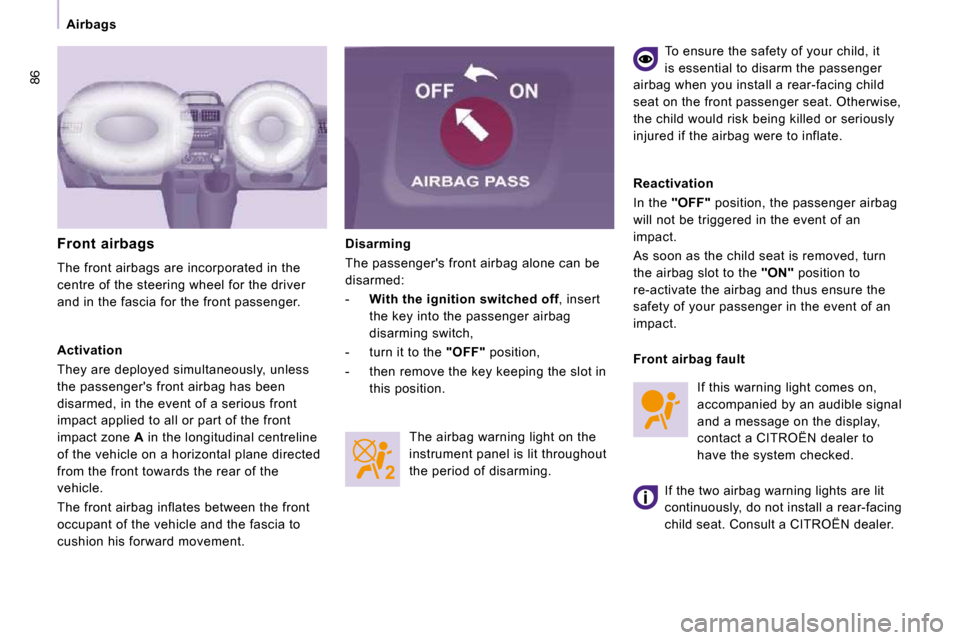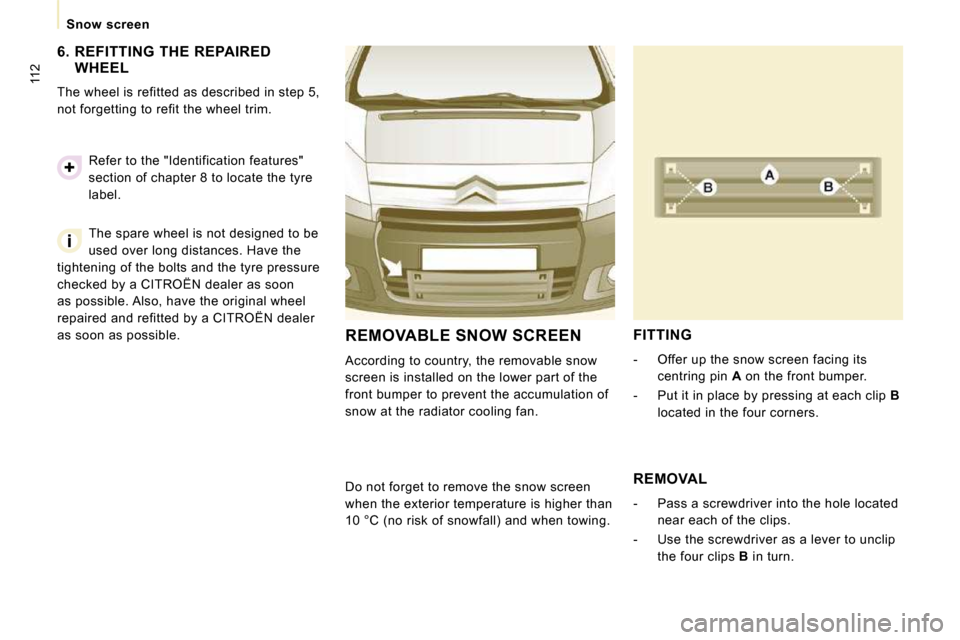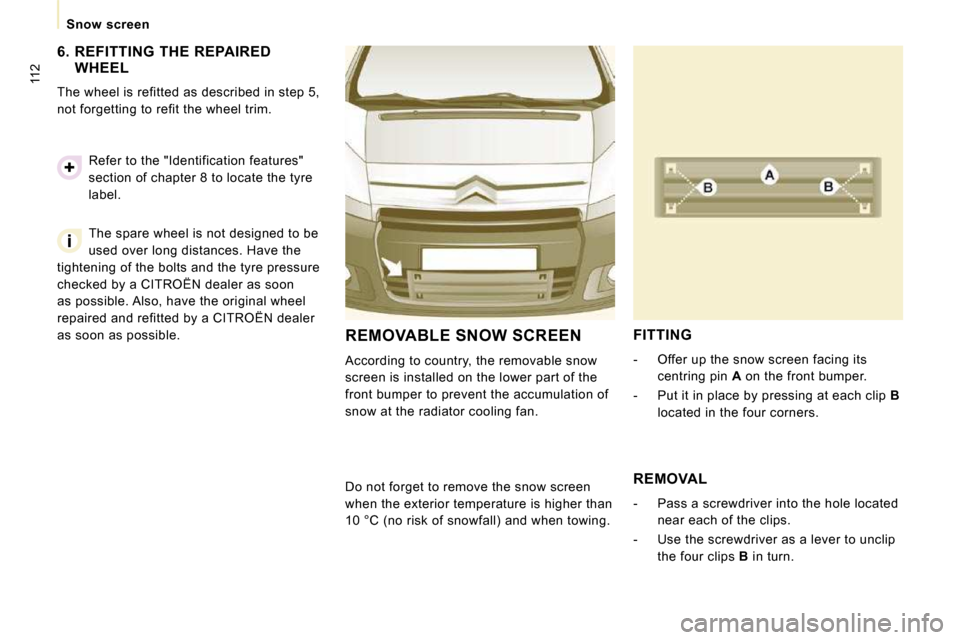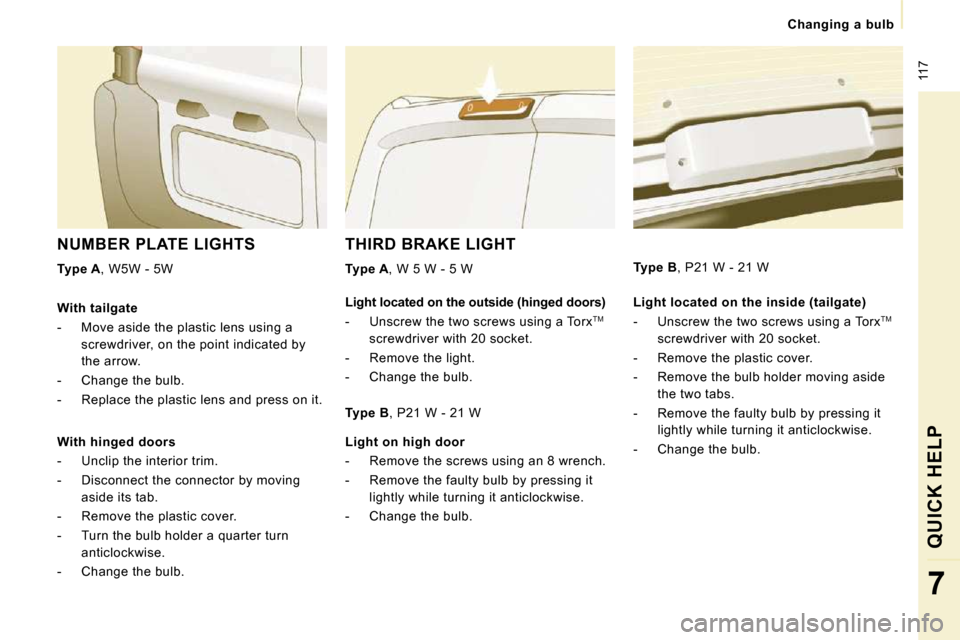driver Citroen JUMPY 2010 2.G Owner's Guide
[x] Cancel search | Manufacturer: CITROEN, Model Year: 2010, Model line: JUMPY, Model: Citroen JUMPY 2010 2.GPages: 225, PDF Size: 10.84 MB
Page 87 of 225

86
Airbags Disarming
The passenger's front airbag alone can be
disarmed:
- With the ignition switched off , insert
the key into the passenger airbag
disarming switch,
- turn it to the "OFF" position,
- then remove the key keeping the slot in this position.
Front airbags
The front airbags are incorporated in the
centre of the steering wheel for the driver
and in the fascia for the front passenger.
Reactivation
In the
"OFF" position, the passenger airbag
will not be triggered in the event of an
impact.
As soon as the child seat is removed, turn
the airbag slot to the "ON" position to
re-activate the airbag and thus ensure the
safety of your passenger in the event of an
impact. To ensure the safety of your child, it
is essential to disarm the passenger
airbag when you install a rear-facing child
seat on the front passenger seat. Otherwise,
the child would risk being killed or seriously
injured if the airbag were to inflate.
The airbag warning light on the
instrument panel is lit throughout
the period of disarming.
Activation
They are deployed simultaneously, unless
the passenger's front airbag has been
disarmed, in the event of a serious front
impact applied to all or part of the front
impact zone
A in the longitudinal centreline
of the vehicle on a horizontal plane directed
from the front towards the rear of the
vehicle.
The front airbag inflates between the front
occupant of the vehicle and the fascia to
cushion his forward movement. If this warning light comes on,
accompanied by an audible signal
and a message on the display,
contact a CITROËN dealer to
have the system checked.
Front airbag fault
If the two airbag warning lights are lit
continuously, do not install a rear-facing
child seat. Consult a CITROËN dealer.
Page 90 of 225

85
Airbags
SAFETY
4
If this warning light comes
on on the instrument panel,
accompanied by an audible signal
and a message on the display,
contact a CITROËN dealer to
have the system checked. The airbags may
no longer be triggered in the event of a
serious impact.
Side airbags
If fitted on your vehicle, this is a system
which protects the driver and front
passenger in the event of a serious side
impact in order to limit the risk of injury to
the chest.
Each side airbag is incorporated in the front
seat back frame, on the door side. Impact detection zones
A. Front impact zone.
B. Side impact zone.
In the event of a minor impact or bump
on the side of the vehicle or if the
vehicle rolls over, the airbag may not be
triggered.
The airbag is not triggered in the event of a
rear or front collision. Operating fault
Activation
It is triggered unilaterally in the event of a
serious side impact applied to all or part
of the side impact zone B , perpendicular
to the longitudinal centreline of the vehicle
on a horizontal plane and directed from the
outside towards the inside of the vehicle.
The side airbag inflates between the
front occupant of the vehicle and the
corresponding door trim pad.
Page 113 of 225

Repairing a wheel
QUICK HELP
7
Warning, the bottle of fluid contains
ethylene-glycol, this product is harmful
if swallowed and causes irritation to the
eyes. Keep this product out of reach of
children.
The expiry date of the fluid is indicated
under the bottle.
The bottle is intended for a single use; once
opened, it must be replaced.
After use, do not discard the bottle into the
environment, take it to a CITROËN dealer or
to a specialised waste disposal site.
Do not forget to obtain a new bottle of
sealant available from CITROËN dealers.
- connect the compressor pipe directly to the valve of the repaired wheel.
- connect the compressor's electrical plug to the vehicle's 12 V socket again,
- start the vehicle again and let the engine run, - adjust the pressure using the
compressor (to inflate: switch A in
position " 1 "; to deflate: switch A in
position " 0 " and press button B ), in
accordance with the vehicle's tyre
pressure label (located on the door
aperture, on the driver's side), then
remember to check that the leak has
been sealed correctly (no further
loss of pressure after several miles
(kilometres)),
- remove the compressor, then stow the complete kit,
- drive at reduced speed (50 mph (80 km/h) max) limiting the distance
travelled to approximately 125 miles
(200 km),
- visit a CITROËN dealer as soon as possible to have the tyre repaired or
replaced by a technician.
Page 117 of 225

111
Changing a wheel
QUICK HELP
7
- Lower the vehicle completely by folding the jack, then remove the jack.
- Tighten the bolts again using the wheelbrace, tighten them fully without
forcing them.
- Place the wheel to be repaired in the carrier. - Secure the carrier on the hook then
raise the carrier using the bolt and the
wheel brace. Check that the wheel and
the carrier are flush against the floor of
the vehicle.
- Remember to close the flap, located on the sill.
- Store the trim in the vehicle.
Never go underneath the vehicle when
it is supported only by the jack.
Never use a screwdriver in place of the
wheelbrace.
5. FITTING THE SPARE WHEEL
- Position the wheel on the hub and start
tightening the wheel bolts by hand.
- Carry out an initial tightening of the bolts using the wheelbrace.
Page 118 of 225

112
Snow screen
6. REFITTING THE REPAIRED WHEEL
The wheel is refitted as described in step 5,
not forgetting to refit the wheel trim.
The spare wheel is not designed to be
used over long distances. Have the
tightening of the bolts and the tyre pressure
checked by a CITROËN dealer as soon
as possible. Also, have the original wheel
repaired and refitted by a CITROËN dealer
as soon as possible. Refer to the "Identification features"
section of chapter 8 to locate the tyre
label.
REMOVABLE SNOW SCREEN
According to country, the removable snow
screen is installed on the lower part of the
front bumper to prevent the accumulation of
snow at the radiator cooling fan.
FITTING
- Offer up the snow screen facing its
centring pin A on the front bumper.
- Put it in place by pressing at each clip B
located in the four corners.
Do not forget to remove the snow screen
when the exterior temperature is higher than
10 °C (no risk of snowfall) and when towing. REMOVAL
- Pass a screwdriver into the hole located
near each of the clips.
- Use the screwdriver as a lever to unclip the four clips B in turn.
Page 119 of 225

112
Snow screen
6. REFITTING THE REPAIRED WHEEL
The wheel is refitted as described in step 5,
not forgetting to refit the wheel trim.
The spare wheel is not designed to be
used over long distances. Have the
tightening of the bolts and the tyre pressure
checked by a CITROËN dealer as soon
as possible. Also, have the original wheel
repaired and refitted by a CITROËN dealer
as soon as possible. Refer to the "Identification features"
section of chapter 8 to locate the tyre
label.
REMOVABLE SNOW SCREEN
According to country, the removable snow
screen is installed on the lower part of the
front bumper to prevent the accumulation of
snow at the radiator cooling fan.
FITTING
- Offer up the snow screen facing its
centring pin A on the front bumper.
- Put it in place by pressing at each clip B
located in the four corners.
Do not forget to remove the snow screen
when the exterior temperature is higher than
10 °C (no risk of snowfall) and when towing. REMOVAL
- Pass a screwdriver into the hole located
near each of the clips.
- Use the screwdriver as a lever to unclip the four clips B in turn.
Page 122 of 225

115
Changing a bulb
QUICK HELP
7
DIRECTION INDICATOR SIDE
REPEATER
Type A , WY 5 W (amber)
- Push the repeater towards the rear and disengage it.
- Support the connector and turn the bulb holder a quarter turn to the left.
- Turn the bulb a quarter turn to the left, remove it and change it.
- When refitting, engage the repeater towards the rear and bring it towards the
front.
Front/Rear
Amber coloured bulbs (direction indicators
and side repeaters) must be replaced with
bulbs of identical specification and colour. COURTESY LIGHTS
Type A , 12 V 5 W - 5 W
- Unclip the lens by sliding a screwdriver in the slots on each side of the courtesy
light.
- Pull the bulb and change it.
- Clip the lens in its housing and ensure that it is secured correctly. High pressure washing
When using this type of washing on
stubborn dirt, do not persist on the
headlamps, the lights and their surrounds to
avoid damaging their coating and their seal.
Page 124 of 225

117
Changing a bulb
QUICK HELP
7
THIRD BRAKE LIGHT
Type A , W 5 W - 5 W
NUMBER PLATE LIGHTS
Type A , W5W - 5W
Light located on the inside (tailgate)
- Unscrew the two screws using a Torx TM
screwdriver with 20 socket.
- Remove the plastic cover.
- Remove the bulb holder moving aside the two tabs.
- Remove the faulty bulb by pressing it lightly while turning it anticlockwise.
- Change the bulb.
Type B , P21 W - 21 W
With tailgate
- Move aside the plastic lens using a
screwdriver, on the point indicated by
the arrow.
- Change the bulb.
- Replace the plastic lens and press on it.
With hinged doors
- Unclip the interior trim.
- Disconnect the connector by moving aside its tab.
- Remove the plastic cover.
- Turn the bulb holder a quarter turn anticlockwise.
- Change the bulb. Light located on the outside (hinged doors)
- Unscrew the two screws using a Torx
TM
screwdriver with 20 socket.
- Remove the light.
- Change the bulb.
Type B , P21 W - 21 W
Light on high door
- Remove the screws using an 8 wrench.
- Remove the faulty bulb by pressing it lightly while turning it anticlockwise.
- Change the bulb.
Page 138 of 225

Weights
WEIGHTS AND TOWED LOADS (KG)
For further information, refer to your registration certificate.
In each country, it is imperative that the towed l oads permitted by local legislation are complied wi th. To find out your vehicle's towing
capabilities and its gross train weight, contact a CITROËN dealer.
Load transfer
If the towing vehicle has not reached the GVW, it is possible to transfer this weight to the trailer.
In all cases, do not exceed the weight of the trai ler and the GTW, indicated on your registration cer tificate.
Comply with the towing capacities of your vehicle.
Engine Body type
Number of
seats
Kerb weight
Maximum
weight (1)
Maximum
payload
Payload
without driver
Braked towed
weight (2)
1.6 HDi 90 Short (L1-H1)
227 2 1 661 2 661 1 000 925 1 672
3 1 673 2 661 988 913 1 672
Short (L1-H1) 229 2 1 661 2 861 1 200 1 125 1 472
3 1 673 2 861 1 188 1 113 1 472
Long (L2-H1) 229 2 1 680 2 880 1 200 1 125 1 453
3 1 692 2 880 1 188 1 113 1 453
Raised
(L2-H2) 229 2 1 700 2 900 1 200 1 125 1 433
3 1 712 2 900 1 188 1 113 1 433
Page 139 of 225

133
Weights
TECHNICAL DATA
8
(1) Gross vehicle weight (GVW).
(2) Braked towed weight with load transfer: this can be increased on condition that the equivalent o f this load is removed from the vehicle so
that the GTW is not exceeded.
High exterior temperatures may result in a reducti on in the performance of the vehicle to protect the engine. When the exterior temperature
is higher than 37 °C, limit the towed weight to 700 kg, without load transfer.
The speed of a towing vehicle must not exceed 60 m ph (100 km/h) (comply with the legislation in force in your country).
Engine Body type
Number of
seats
Kerb weight
Maximum
weight (1)
Maximum
payload
Payload
without driver
Braked towed
weight (2)
2.0 HDi 120 and
2.0 HDi 120 PEF Short (L1-H1)
227 2 1 702 2 702 1 000 925 2 000
3 1 714 2 702 988 913 2 000
Short (L1-H1) 229 2 1 702 2 902 1 200 1 125 1 998
3 1 714 2 902 1 188 1 113 1 998
Long (L2-H1) 229 2 1 732 2 932 1 200 1 125 1 968
3 1 744 2 932 1 188 1 113 1 968
Raised
(L2-H2)
229 2 1 763 2 963 1 200 1 125 1 937
3 1 775 2 963 1 188 1 113 1 937